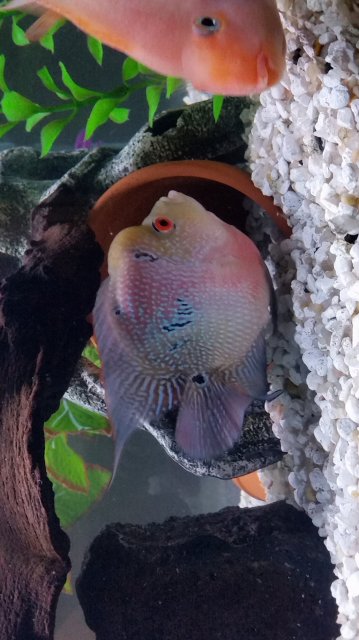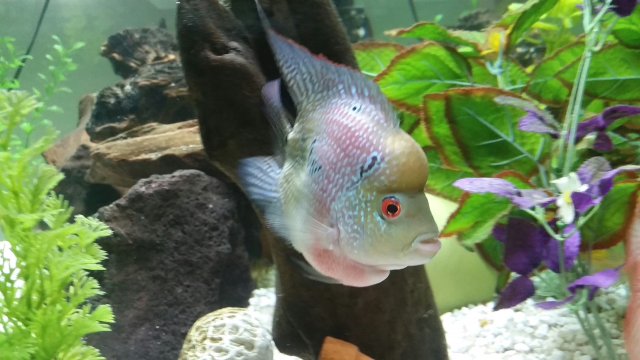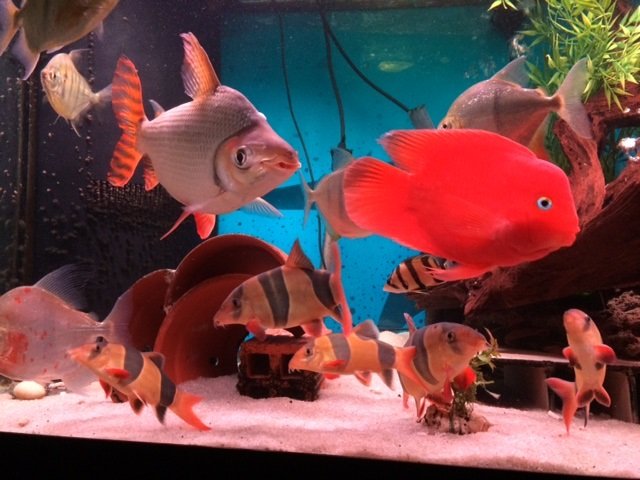You are using an out of date browser. It may not display this or other websites correctly.
You should upgrade or use an alternative browser.
You should upgrade or use an alternative browser.
Parrot Cichlid Info sheet: Blood Parrots, King Kong Parrots, and Kirin Parrots.
- Thread starter Chrisplosion
- Start date
Looks like a short body fh to me.
What kind of fish is that big guy in the middle - silver, orange tail, strange face???? He is amazing.
Okay gang, I need help (information). To my delight, I accidentally acquired what seems to be a kilin/kirin(?). I thought I was buying a blood parrot. So I have been researching to identify him. I would love for someone to confirm my suspicions.
Then, because I identified him as a male, I put him with one of my female blood parrots. Well, have spawned! There are about 70-80 fry (maybe more) and are about 1 week old, free-swimming, and seems to be doing well. Both parents are very attentive. The family is currently living in a 40 gallon breeder (no other tankmates). I hope these are very special fish and I want to grow them out properly. My questions:
1. what kind of fish is my male (see photo)?
2. What can I expect these fry to look like as adults? Are they , in fact, as special as I am hoping (the babies)? Or, will they simply be a weird batch of fish clearly bred by someone who doesn't know any better? In other words, are they likely to be appreciated and desired by folks like you guys?
3. I REALLY need advice about how to properly grown them out - grow-out tanks, time frames, etc.
Please help! I really want to know more and do the proper things. FYI, I have some experience growing out fry, but only with different, much smaller fish types.
Thank you in advance!!







Then, because I identified him as a male, I put him with one of my female blood parrots. Well, have spawned! There are about 70-80 fry (maybe more) and are about 1 week old, free-swimming, and seems to be doing well. Both parents are very attentive. The family is currently living in a 40 gallon breeder (no other tankmates). I hope these are very special fish and I want to grow them out properly. My questions:
1. what kind of fish is my male (see photo)?
2. What can I expect these fry to look like as adults? Are they , in fact, as special as I am hoping (the babies)? Or, will they simply be a weird batch of fish clearly bred by someone who doesn't know any better? In other words, are they likely to be appreciated and desired by folks like you guys?
3. I REALLY need advice about how to properly grown them out - grow-out tanks, time frames, etc.
Please help! I really want to know more and do the proper things. FYI, I have some experience growing out fry, but only with different, much smaller fish types.
Thank you in advance!!








Thanks for the infoBlood Parrot Cichlid
Description
Common Names: Blood Parrot Cichlid, Red Blood Parrot, Red Parrot Cichlid, Red Parrot Fish
The Blood Parrot Cichlid is a hybrid fish that was first created in Taiwan in the mid to late 1980's. Its parentage has been highly disputed, but the most commonly speculated pairings are Midas Cichlid (Amphilophus Citrinellus) or Red Devil (Amphilophus Labiatus) with the Redhead Cichlid (Vieja Synspilum). This pairing has been back by the out come of a few different pairing and the resulting fry coming out as early Parrot Cichlids. The Taiwanese Department of Zoology also acknowledges that his is the true parentage of the Blood Parrot. One common misconception is that the are the result of Severum (Heros Severus) crossed with the Red Devil Cichlid (Amphilophus Labiatus).
Blood Parrots have a round body, a beak shaped head with an upside down triangle mouth. They are often seen in bright orange in coloration, but seen in other colors such as red, yellow, brown, and tan. Other colors have been produced such as green, blue, and purple by dyeing the fish, which shortens life expectancy.
View attachment 808845
Tank Size
30 Gallons Minimum
A good rule of thumb is 30 gallon for one and 10 more gallons for each additional Blood Parrot. As with any fish, the bigger the tank the better.
Size and Growth
6 - 9" (15 - 24cm)
Blood Parrots grow slow when compared to other Central American Cichlids or Flowerhorn. Once they hit 4-5" their growth slows further. They typically can live anywhere from 5 - 15 years depending on the care given to them and other genetic factors.
When Blood Parrots are small they may show a tan/brown body color with black spots near the tail. These are unpeeled juveniles that should peel to orange/yellow as it grows.
View attachment 808880
Some may never peel to orange/yellow and stray tan/brown. Lots of Parrots like this are usually sold cheaper than the normal orange ones at places like Petsmart.
View attachment 808882
Water Condition
Temperature: 76 - 86F (24 - 30C)
pH: 6.0 - 8.5
Temperatures should be between 76 - 86F (24 - 30C) but the ideal temperature should be between 80 - 84F (24 - 29C). Temperatures lower than 80F (24C) seems to cause them to be more reclusive and cause the color to be more pale. The ideal pH should be between 7.0 - 8.0.
Feeding
Blood Parrots enjoy pelleted foods with occasional Blood Worm and Shrimp treats. A smaller pellet size should be used due to their mouths. Recommended pellet brands are Hikari Cichlid or New Life Spectrum Cichlid/Cichlasoma Formula 1 - 3mm depending on the size of the fish.
Feeding can sometimes be tricky as some have more deformed mouths than others or gill curl or other gill deformities. If the Parrot has trouble feeding from the surface then it is recommended to switch to a sinking pellet. You can also soak the pellets in water to soften them which are much easier to grab.
Thawed shelled peas should be fed once a week to add ruffa.ge to the diet to help prevent Swim Bladder problems.
Social Behavior
Blood Parrots, especially when young, can be very shy and reclusive. Its typical for them to hide when you first bring them home to hide and/or be very skittish and can take a few weeks for them to adjust to their new surroundings. Some ways for you to help them adjust is to make sure they have several hiding spots and adding some dither fish. Removing hiding spots will only make them more shy and could take longer for them to adjust.
Blood Parrots like all Central American Cichlids are territorial and not typically suitable for small community fish. If it fits in their mouth or close then they will try to eat it. Given the proper tank Blood Parrots typically get along fine with most Central and Southern American Cichlids although large overly aggressive cichlids should be avoided as tankmates or house with caution.
Due to Blood Parrots deformed mouths they cannot cause much damage to other fish although recently low quality Blood Parrots are being produced to sell at cheaper prices that do not have the deformed mouth and they can do damage.
Health Issues
Stress Spots: This is usually mistaken for Neascus (Black spot disease). Blood Parrots sometimes get Stress Spots which are black splotches on the body or fins and this is caused by stress. This is typically present you bring them home but can also show up when in cases of shyness, bullying, breeding, illness, or sometimes nothing at all. The splotches will usually disappear after awhile once the problem is taken care of.
View attachment 808883
Swim Bladder Issues: They show an abnormal swimming pattern, may even float upside down or appear to be stuck at the surface of the water, being unable to swim down, or they may lie on the bottom, unable to rise. Fish with a swim bladder disorder will continue to try and feed, showing a normal appetite. This is usually caused by a poor diet.
To prevent this from happening it is recommended to feed shelled peas once a week for that days meals. This can also help with mild cases.
You can also ad 1Tbsp per 5 gallons of Epsom salt to the tank.
For severe cases add 1 Tbsp per gallon of Epsom Salt into a container of water. Place the fish in the Epsom Salt bath for 20 - 30 minutes. This can be done twice a day.
Sexual Differences
Blood Parrots are not sexually dimorphic which means you can not look at one and be able to sex it. The only proper why to tell the gender is to vent them.
View attachment 808886
Breeding
Blood Parrots will start to pair off and breed around 2 - 3" (5 - 7.5cm). Nearly all male Blood Parrots are sterile which means they can not fertilize the eggs. Female Blood Parrots however can cross with any male Central American Cichlid or any Hybrid Central American Cichlid and the eggs be viable. South American Cichlid (except Cichlasoma Festae) and African Cichlid can not cross with female Blood Parrots.
If the eggs turn white then they are no good and should be removed to prevent dirtying the water. Good eggs should turn tan with a black dot and hatch after 2-4 depending on water temperature.
Low Quality Blood Parrots
Recently there has been lots of low quality Blood Parrots showing up in the market at stores like Petco, Petsmart, Walmart, and some local stores at significantly lower prices than they are typically seen. These Parrots are low quality in the way the ideal Blood Parrot should look like. These low quality parrots are being mistaken as King Kong Parrots because they posses normal closing mouths rather than the upside down triangle mouth and they do not posses the hump like body.
View attachment 808890
Dyed and Mutilated Parrots
Blood Parrots and many other fish have been the victims of cruel cosmetic surgery where the fish is dyed or mutilated in order to "enhance" its beauty at the cost of greatly shortening its life span.
Dyeing: Dyeing (also known as artificial coloring or juicing), is achieved by a number of methods, such as tattooing, injecting the fish with a hypodermic syringe containing bright fluorescent color dye and dipping the fish into a dye solution among others. This process is usually done to make the fish a brighter color and more attractive to consumers. The coloring of the fish is not permanent, and usually fades away in six to nine months.
View attachment 808891
View attachment 808892
These fish are usually referred to as Green/Blue/Purple Parrots, Jellybean Parrots and Bubblegum Parrots.
Amputation: Amputation is perhaps the worst and most inhumane method of cosmetic fish surgery. Its victims are usually Blood Parrots and Flowerhorn. The fish's tail is cut off with scissors while at a young age so as it grows the body produces a sort of "heart" shape as it grows.
View attachment 808893
View attachment 808894
These fish are usually referred to as Heart Parrots and Love Parrots.
View attachment 808880
View attachment 808882
View attachment 808883
View attachment 808886
View attachment 808890
View attachment 808892
View attachment 808894
I recently purchased a Blood Parrot cichlid. When i got him/her there was another in the tank. They stayed together in the hour i spent deciding on which to get. Now mine seems lethargic and so does the other still at the store. So my question is do they bond with each other? I know it sounds silly but this is my first after a year of research.
Zacks Tanks
Gambusia
This is the best thread about Blood Parrots/related fish, I've ever seen. Great work!
I concur, learned so much! Thank you who didi this awesome tread with massive info. Best Regards Crazy Aquarium guy on Youtube.



